IPSec - PIX to Cisco VPN Client Wild-card, Pre-shared, Mode Configuration with Extended Authentication
Available Languages
Contents
Introduction
This configuration example demonstrates how to connect a VPN Client to a PIX Firewall using wildcards, mode-config, the sysopt connection permit-ipsec command, and extended authentication (Xauth).
In order to see the TACACS+ and RADIUS configuration for PIX 6.3 and later, refer to TACACS+ and RADIUS for PIX 6.3 and PIX/ASA 7.x Configuration Example.
The VPN Client supports Advanced Encryption Standard (AES) as an encryption algorithm in Cisco VPN Client release 3.6.1 and later and with PIX Firewall 6.3. The VPN Client supports key sizes of 128 bits and 256 bits only. For more information on how to configure AES, refer to How to Configure the Cisco VPN Client to PIX with AES.
Refer to PIX/ASA 7.x and Cisco VPN Client 4.x for Windows with Microsoft Windows 2003 IAS RADIUS Authentication Configuration Example to set up the remote access VPN connection between a Cisco VPN Client (4.x for Windows) and the PIX 500 Series Security Appliance 7.x using a Microsoft Windows 2003 Internet Authentication Service (IAS) RADIUS server.
Refer to IPsec Between a VPN 3000 Concentrator and a VPN Client 4.x for Windows using RADIUS for User Authentication and Accounting Configuration Example to establish an IPsec tunnel between a Cisco VPN 3000 Concentrator and a Cisco VPN Client 4.x for Windows using RADIUS for user authentication and accounting.
Refer to Configuring IPsec Between a Cisco IOS Router and a Cisco VPN Client 4.x for Windows Using RADIUS for User Authentication to configure a connection between a router and the Cisco VPN Client 4.x using RADIUS for user authentication.
Prerequisites
Requirements
There are no specific requirements for this document.
Components Used
The information in this document is based on these software and hardware versions:
-
Cisco VPN Client 4.x. This product has advanced VPN features, unlike the Cisco Secure VPN Client 1.x.
-
PIX Firewall 515E version 6.3(3).
Note: Encryption technology is subject to export controls. It is your responsibility to know the law regarding export of encryption technology. For more information, refer to the Bureau of Export Administration web site ![]() . If you have any questions regarding export control, please send an email to export@cisco.com.
. If you have any questions regarding export control, please send an email to export@cisco.com.
The information in this document was created from the devices in a specific lab environment. All of the devices used in this document started with a cleared (default) configuration. If your network is live, make sure that you understand the potential impact of any command.
Conventions
Refer to Cisco Technical Tips Conventions for more information on document conventions.
Background Information
The sysopt connection permit-ipsec command implicitly permits any packet that comes from an IPsec tunnel to bypass the checking of an associated access-list, conduit, or access-group command for IPsec connections. Xauth authenticates the IPsec user to an external TACACS+ or RADIUS server. In addition to the wild-card pre-shared key, the user must provide a username/password.
A user with a VPN Client receives an IP address from their ISP. This is replaced by an IP address from the IP address pool on the PIX. The user has access to everything on the inside of the firewall, including networks. Users who do not run the VPN Client can connect only to the web server using the outside address provided by the static assignment.
Configure
In this section, you are presented with the information to configure the features described in this document.
Note: Use the Command Lookup Tool (registered customers only) to find more information on the commands used in this document.
Network Diagram
This document uses this network setup:
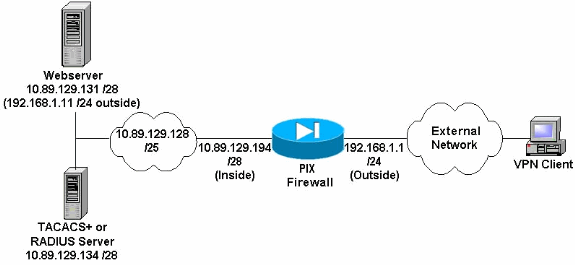
Network Diagram Notes
-
Internet hosts which access the web server using the global IP address 192.168.1.1 are authenticated even if a VPN connection is not established. This traffic is not encrypted.
-
VPN Clients are able to access all hosts on the inside network (10.89.129.128 /25) once their IPsec tunnel is established. All traffic from the VPN Client to the PIX Firewall is encrypted. Without an IPsec tunnel, they are only able to access the web server via its global IP address but are still required to authenticate.
-
VPN Clients come from the Internet and their IP addresses are not known in advance.
Configurations
This document uses these configurations.
| PIX Configuration 6.3(3) |
|---|
pixfirewall#show run : Saved : PIX Version 6.3(3) interface ethernet0 100full interface ethernet1 100full nameif ethernet0 outside security0 nameif ethernet1 inside security100 enable password 8Ry2YjIyt7RRXU24 encrypted passwd 2KFQnbNIdI.2KYOU encrypted hostname pixfirewall fixup protocol dns maximum-length 512 fixup protocol ftp 21 fixup protocol h323 h225 1720 fixup protocol h323 ras 1718-1719 fixup protocol http 80 fixup protocol rsh 514 fixup protocol rtsp 554 fixup protocol sip 5060 fixup protocol sip udp 5060 fixup protocol skinny 2000 fixup protocol smtp 25 fixup protocol sqlnet 1521 fixup protocol tftp 69 names !--- Do not use Network Address Translation (NAT) for inside-to-pool !--- traffic. This should not go through NAT. access-list 101 permit ip 10.89.129.128 255.255.255.240 10.89.129.192 255.255.255.240 !--- Permits Internet Control Message Protocol (ICMP) !--- Transmission Control Protocol (TCP) and User Datagram Protocol (UDP) !--- traffic from any host on the Internet (non-VPN) to the web server. access-list 120 permit icmp any host 10.89.129.131 access-list 120 permit tcp any host 10.89.129.131 access-list 120 permit udp any host 10.89.129.131 pager lines 24 mtu outside 1500 mtu inside 1500 ip address outside 192.168.1.1 255.255.255.0 ip address inside 10.89.129.194 255.255.255.240 ip audit info action alarm ip audit attack action alarm !--- Specifies the inside IP address range to be assigned !--- to the VPN Clients. ip local pool VPNpool 10.89.129.200-10.89.129.204 no failover failover timeout 0:00:00 failover poll 15 no failover ip address outside no failover ip address inside pdm history enable arp timeout 14400 !--- Defines a pool of global addresses to be used by NAT. global (outside) 1 192.168.1.6-192.168.1.10 nat (inside) 0 access-list 101 nat (inside) 1 0.0.0.0 0.0.0.0 0 0 !--- Specifies which outside IP address to apply to the web server. static (inside,outside) 192.168.1.11 10.89.129.131 netmask 255.255.255.255 0 0 !--- Apply ACL 120 to the outside interface in the inbound direction. access-group 120 in interface outside !--- Defines a default route for the PIX. route outside 0.0.0.0 0.0.0.0 192.168.1.3 1 !--- Defines a route for traffic within the PIX's !--- subnet to reach other inside hosts. route inside 10.89.129.128 255.255.255.128 10.89.129.193 1 timeout xlate 3:00:00 timeout conn 1:00:00 half-closed 0:10:00 udp 0:02:00 rpc 0:10:00 h225 1:00:00 timeout h323 0:05:00 mgcp 0:05:00 sip 0:30:00 sip_media 0:02:00 timeout uauth 0:05:00 absolute aaa-server TACACS+ protocol tacacs+ aaa-server RADIUS protocol radius aaa-server LOCAL protocol local !--- Authentication, authorization, and accounting (AAA) statements !--- for authentication. !--- Use either of these statements to define the protocol of the group AuthInbound. !--- You cannot use both. aaa-server AuthInbound protocol tacacs+ !--- OR aaa-server AuthInbound protocol radius !--- After you define the protocol of the group AuthInbound, define !--- a server of the same type. !--- In this case we specify the TACACS+ server and key of "secretkey". aaa-server AuthInbound (inside) host 10.89.129.134 secretkey timeout 10 !--- Authenticate HTTP, FTP, and Telnet traffic to the web server. aaa authentication include http outside 10.89.129.131 255.255.255.255 0.0.0.0 0.0.0.0 AuthInbound aaa authentication include ftp outside 10.89.129.131 255.255.255.255 0.0.0.0 0.0.0.0 AuthInbound aaa authentication include telnet outside 10.89.129.131 255.255.255.255 0.0.0.0 0.0.0.0 AuthInbound no snmp-server location no snmp-server contact snmp-server community public no snmp-server enable traps floodguard enable !--- Trust IPsec traffic and avoid going through ACLs/NAT. sysopt connection permit-ipsec !--- IPsec and dynamic map configuration. crypto ipsec transform-set myset esp-des esp-md5-hmac crypto dynamic-map dynmap 10 set transform-set myset crypto map mymap 10 ipsec-isakmp dynamic dynmap !--- Assign IP address for VPN 1.1 Clients. crypto map mymap client configuration address initiate crypto map mymap client configuration address respond !--- Use the AAA server for authentication (AuthInbound). crypto map mymap client authentication AuthInbound !--- Apply the IPsec/AAA/ISAKMP configuration to the outside interface. crypto map mymap interface outside isakmp enable outside !--- Pre-shared key for VPN 1.1 Clients. isakmp key ******** address 0.0.0.0 netmask 0.0.0.0 isakmp identity address !--- Assign address from "VPNpool" pool for VPN 1.1 Clients. isakmp client configuration address-pool local VPNpool outside !--- ISAKMP configuration for VPN Client 3.x/4.x. isakmp policy 10 authentication pre-share isakmp policy 10 encryption des isakmp policy 10 hash md5 isakmp policy 10 group 2 isakmp policy 10 lifetime 86400 !--- ISAKMP configuration for VPN Client 1.x. isakmp policy 20 authentication pre-share isakmp policy 20 encryption des isakmp policy 20 hash md5 isakmp policy 20 group 1 isakmp policy 20 lifetime 86400 !--- Assign addresses from "VPNpool" for VPN Client 3.x/4.x. vpngroup vpn3000 address-pool VPNpool vpngroup vpn3000 idle-time 1800 !--- Group password for VPN Client 3.x/4.x (not shown in configuration). vpngroup vpn3000 password ******** telnet timeout 5 ssh timeout 5 console timeout 0 terminal width 80 Cryptochecksum:ba54c063d94989cbd79076955dbfeefc : end pixfirewall# |
VPN Client 4.0.5 Configuration
Complete these steps to configure the VPN Client 4.0.5.
-
Select Start > Programs > Cisco Systems VPN Client > VPN Client.
-
Click New to launch the Create New VPN Connection Entry window.
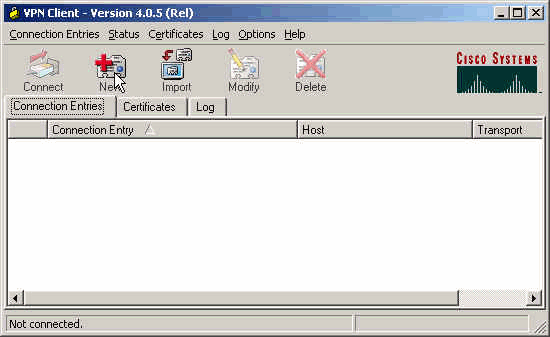
-
Enter the name of the Connection Entry along with a description. Enter the outside IP address of the PIX Firewall in the Host box. Then enter the VPN Group name and password and click Save.
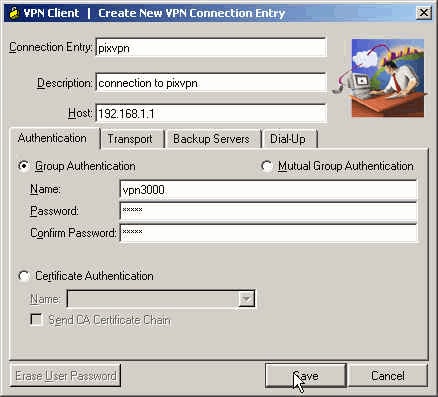
-
From the VPN Client main window, click on the connection you would like to use and click the Connect button.
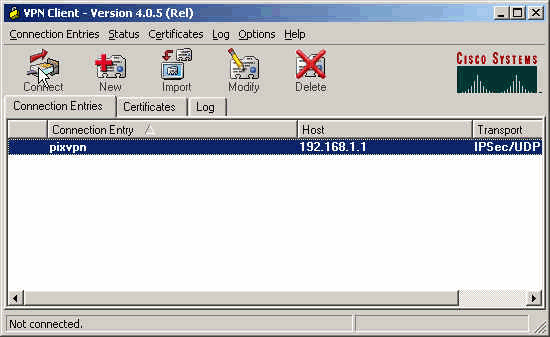
-
When prompted, enter the Username and Password information for Xauth and click OK to connect to the remote network.
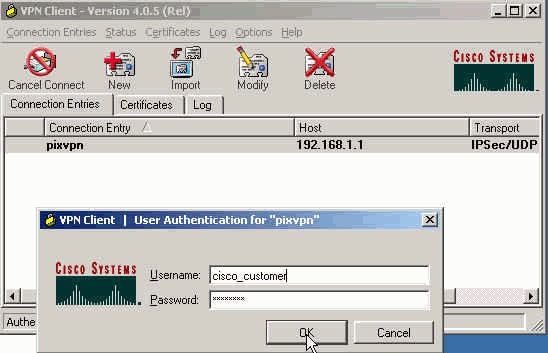
VPN Client 3.5 Configuration
Complete these steps to configure the VPN Client 3.5 configuration.
-
Select Start > Programs > Cisco Systems VPN Client > VPN Dialer.
-
Click New to launch the New Connection Entry Wizard.
-
Enter the name of your new connection entry and click Next.
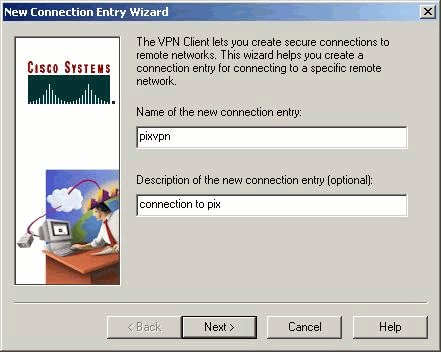
-
Enter the host name or IP address of the server that is used to connect to the remote server and click Next.
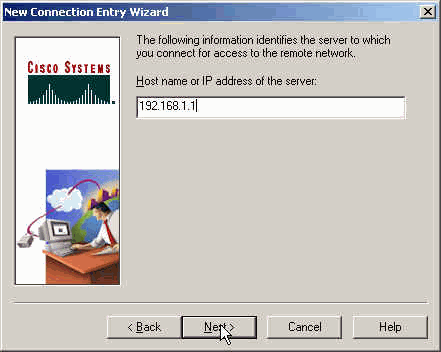
-
Select Group Access Information and enter the Name and Password that is used to authenticate your access to the remote server. Click Next.
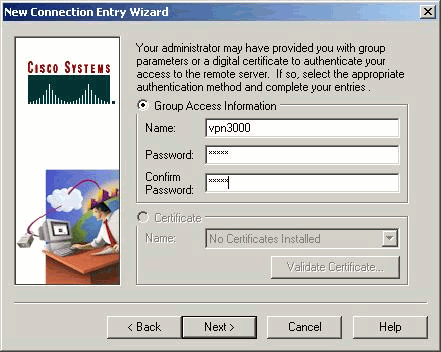
-
Click Finish to save the new entry.

-
Select the Connection Entry in the dialer and click Connect.
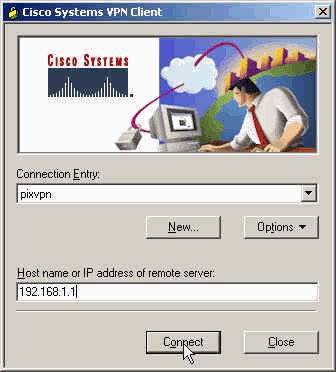
-
When prompted, enter the Username and Password information for Xauth and click OK to connect to the remote network.
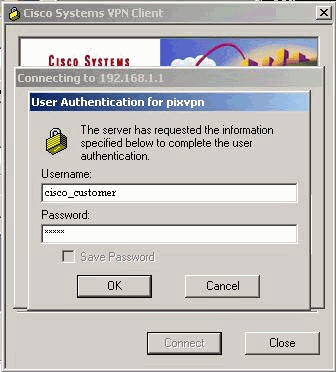
| VPN Client 1.1 Configuration |
|---|
Network Security policy:
1- TACconn
My Identity
Connection security: Secure
Remote Party Identity and addressing
ID Type: IP subnet
10.89.129.128
255.255.255.128
Port all Protocol all
Connect using secure tunnel
ID Type: IP address
192.168.1.1
Pre-shared Key=cisco1234
Authentication (Phase 1)
Proposal 1
Authentication method: pre-shared key
Encryp Alg: DES
Hash Alg: MD5
SA life: Unspecified
Key Group: DH 1
Key exchange (Phase 2)
Proposal 1
Encapsulation ESP
Encrypt Alg: DES
Hash Alg: MD5
Encap: tunnel
SA life: Unspecified
no AH
2- Other Connections
Connection security: Non-secure
Local Network Interface
Name: Any
IP Addr: Any
Port: All |
Add Accounting
The syntax of the command to add accounting is:
aaa accounting include acctg_service inbound|outbound l_ip l_mask [f_ip f_mask] server_tag
For example, in the PIX configuration, this command is added:
aaa accounting include any inbound 0.0.0.0 0.0.0.0 0.0.0.0 0.0.0.0 AuthInbound
Note: The sysopt connection permit-ipsec command, not the sysopt ipsec pl-compatible command, is necessary for Xauth accounting to work. Xauth accounting does not work with only the sysopt ipsec pl-compatible command. Xauth accounting is valid for TCP connections, not ICMP or UDP.
This output is an example of TACACS+ accounting records:
07/27/2004 15:17:54 cisco_customer Default Group 10.89.129.200 stop 15 .. 99 1879 .. .. 0x5 .. PIX 10.89.129.194 telnet 07/27/2004 15:17:39 cisco_customer Default Group 10.89.129.200 start .. .. .. .. .. .. 0x5 .. PIX 10.89.129.194 telnet
Verify
Use this section to confirm that your configuration works properly.
The Output Interpreter Tool (registered customers only) (OIT) supports certain show commands. Use the OIT to view an analysis of show command output.
Note: Refer to Important Information on Debug Commands before you use debug commands.
Enable the Cisco Secure Log Viewer in order to see the client-side debugs.
-
debug crypto ipsec—Used to see the IPsec negotiations of phase 2.
-
debug crypto isakmp—Used to see the ISAKMP negotiations of phase 1.
Troubleshoot
This section provides information you can use to troubleshoot your configuration. Sample debug output is also shown.
Troubleshooting Commands
The Output Interpreter Tool (registered customers only) (OIT) supports certain show commands. Use the OIT to view an analysis of show command output.
Note: Refer to Important Information on Debug Commands before you use debug commands.
-
debug crypto engine—Used to debug the crypto engine process.
PIX Debug Sample
pixfirewall#show debug
debug crypto ipsec 1
debug crypto isakmp 1
debug crypto engine
debug fover status
tx Off
rx Off
open Off
cable Off
txdmp Off
rxdmp Off
ifc Off
rxip Off
txip Off
get Off
put Off
verify Off
switch Off
fail Off
fmsg Off
Debugs with VPN Client 4.x
pixfirewall#
crypto_isakmp_process_block: src 192.168.1.2, dest 192.168.1.1
VPN Peer: ISAKMP: Added new peer: ip:192.168.1.2
Total VPN Peers:1
VPN Peer: ISAKMP: Peer ip:192.168.1.2 Ref cnt incremented
to:1 Total VPN Peers:1
OAK_AG exchange
ISAKMP (0): processing SA payload. message ID = 0
ISAKMP (0): Checking ISAKMP transform 1 against priority 10 policy
ISAKMP: encryption 3DES-CBC
ISAKMP: hash SHA
ISAKMP: default group 2
ISAKMP: extended auth pre-share
ISAKMP: life type in seconds
ISAKMP: life duration (VPI) of 0x0 0x20 0xc4 0x9b
ISAKMP (0): atts are not acceptable. Next payload is 3
ISAKMP (0): Checking ISAKMP transform 2 against priority 10 policy
ISAKMP: encryption 3DES-CBC
ISAKMP: hash MD5
ISAKMP: default group 2
ISAKMP: extended auth pre-share
ISAKMP: life type in seconds
ISAKMP: life duration (VPI) of 0x0 0x20 0xc4 0x9b
ISAKMP (0): atts are not acceptable. Next payload is 3
ISAKMP (0): Checking ISAKMP transform 3 against priority 10 policy
ISAKMP: encryption 3DES-CBC
ISAKMP: hash SHA
ISAKMP: default group 2
ISAKMP: auth pre-shared
ISAKMP: life type in seconds
ISAKMP: life duration (VPI) of 0x0 0x20 0xc4 0x9b
ISAKMP (0): atts are not acceptable. Next payload is 3
ISAKMP (0): Checking ISAKMP transform 4 against priority 10 policy
ISAKMP: encryption 3DES-CBC
ISAKMP: hash MD5
ISAKMP: default group 2
ISAKMP: auth pre-share
ISAKMP: life type in seconds
ISAKMP: life duration (VPI) of 0x0 0x20 0xc4 0x9b
ISAKMP (0): atts are not acceptable. Next payload is 3
ISAKMP (0): Checking ISAKMP transform 5 against priority 10 policy
ISAKMP: encryption DES-CBC
ISAKMP: hash SHA
ISAKMP: default group 2
ISAKMP: extended auth pre-share
ISAKMP: life type in seconds
ISAKMP: life duration (VPI) of 0x0 0x20 0xc4 0x9b
ISAKMP (0): atts are not acceptable. Next payload is 3
ISAKMP (0): Checking ISAKMP transform 6 against priority 10 policy
ISAKMP: encryption DES-CBC
ISAKMP: hash MD5
ISAKMP: default group 2
ISAKMP: extended auth pre-share
ISAKMP: life type in seconds
ISAKMP: life duration (VPI) of 0x0 0x20 0xc4 0x9b
ISAKMP (0): atts are acceptable. Next payload is 3
!--- Attributes offered by the VPN Client are accepted by the PIX.
ISAKMP (0): processing KE payload. message ID = 0
ISAKMP (0): processing NONCE payload. message ID = 0
ISAKMP (0): processing ID payload. message ID = 0
ISAKMP (0): processing vendor id payload
ISAKMP (0): processing vendor id payload
ISAKMP (0): remote peer supports dead peer detection
ISAKMP (0): processing vendor id payload
ISAKMP (0): speaking to a Unity client
ISAKMP (0): ID payload
next-payload: 10
type : 1
protocol : 17
port : 500
length : 8
ISAKMP (0) : Total payload length: 12
return status is IKMP_NO_ERROR
crypto_isakmp_process_block: src 192.168.1.2, dest 192.168.1.1 OAK_AG exchange
ISAKMP (0): processing HASH payload. message ID = 0
ISAKMP (0): processing NOTIFY payload 24578 protocol 1
spi 0, message ID = 0
ISAKMP (0): processing notify INITIAL_CONTACT
IPSEC(key_engine): got a queue event...
IPSEC(key_engine_delete_sas): rec'd delete notify from ISAKMP
IPSEC(key_engine_delete_sas): delete all SAs
shared with 192.168.1.2
ISAKMP (0): SA has been authenticated
return status is IKMP_NO_ERROR
ISAKMP/xauth: request attribute XAUTH_TYPE
ISAKMP/xauth: request attribute XAUTH_USER_NAME
ISAKMP/xauth: request attribute XAUTH_USER_PASSWORD
ISAKMP (0:0): initiating peer config to 192.168.1.2.
ID = 1623347510 (0x60c25136) crypto_isakmp_process_block: src 192.168.1.2,
dest 192.168.1.1
ISAKMP_TRANSACTION exchange
ISAKMP (0:0): processing transaction payload
from 192.168.1.2. message ID = 84
ISAKMP: Config payload CFG_REPLY
return status is IKMP_ERR_NO_RETRANS
ISAKMP (0:0): initiating peer config to 192.168.1.2.
ID = 2620656926 (0x9c340d1e) crypto_isakmp_process_block: src 192.168.1.2,
dest 192.168.1.1
ISAKMP_TRANSACTION exchange
ISAKMP (0:0): processing transaction payload
from 192.168.1.2. message ID = 60
ISAKMP: Config payload CFG_ACK
return status is IKMP_NO_ERROR
crypto_isakmp_process_block: src 192.168.1.2, dest 192.168.1.1
ISAKMP_TRANSACTION exchange
ISAKMP (0:0): processing transaction payload
from 192.168.1.2. message ID = 0
ISAKMP: Config payload CFG_REQUEST
ISAKMP (0:0): checking request:
ISAKMP: attribute IP4_ADDRESS (1)
ISAKMP: attribute IP4_NETMASK (2)
ISAKMP: attribute IP4_DNS (3)
ISAKMP: attribute IP4_NBNS (4)
ISAKMP: attribute ADDRESS_EXPIRY (5)
Unsupported Attr: 5
ISAKMP: attribute APPLICATION_VERSION (7)
Unsupported Attr: 7
ISAKMP: attribute UNKNOWN (28672)
Unsupported Attr: 28672
ISAKMP: attribute UNKNOWN (28673)
Unsupported Attr: 28673
ISAKMP: attribute UNKNOWN (28674)
ISAKMP: attribute UNKNOWN (28676)
ISAKMP: attribute UNKNOWN (28679)
Unsupported Attr: 28679
ISAKMP: attribute UNKNOWN (28680)
Unsupported Attr: 28680
ISAKMP: attribute UNKNOWN (28677)
Unsupported Attr: 28677
ISAKMP (0:0): responding to peer config from 192.168.1.2. ID = 177917346
return status is IKMP_NO_ERROR
crypto_isakmp_process_block: src 192.168.1.2, dest 192.168.1.1
OAK_QM exchange
oakley_process_quick_mode:
OAK_QM_IDLE
ISAKMP (0): processing SA payload. message ID = 942875080
ISAKMP : Checking IPSec proposal 1
ISAKMP: transform 1, ESP_3DES
ISAKMP: attributes in transform:
ISAKMP: authenticator is HMAC-MD5
ISAKMP: encaps is 1
ISAKMP: SA life type in seconds
ISAKMP: SA life duration (VPI) of 0x0 0x20 0xc4 0x9b
IPSEC(validate_proposal): transform
proposal (prot 3, trans 3, hmac_alg 1) not supported
ISAKMP (0): atts not acceptable. Next payload is 0
ISAKMP (0): skipping next ANDed proposal (1)
ISAKMP : Checking IPSec proposal 2
ISAKMP: transform 1, ESP_3DES
ISAKMP: attributes in transform:
ISAKMP: authenticator is HMAC-SHA
ISAKMP: encaps is 1
ISAKMP: SA life type in seconds
ISAKMP: SA life duration (VPI) of 0x0 0x20 0xc4 0x9b
IPSEC(validate_proposal): transform
proposal (prot 3, trans 3, hmac_alg 2) not supported
ISAKMP (0): atts not acceptable. Next payload is 0
ISAKMP (0): skipping next ANDed proposal (2)
ISAKMP: Checking IPSec proposal 3
ISAKMP: transform 1, ESP_3DES
ISAKMP: attributes in transform:
ISAKMP: authenticator is HMAC-MD5
ISAKMP: encaps is 1
ISAKMP: SA life type in seconds
ISAKMP: SA life duration (VPI) of 0x0 0x20 0xc4 0x9b
IPSEC(validate_proposal): transform
proposal (prot 3, trans 3, hmac_alg 1) not supported
ISAKMP (0): atts not acceptable. Next payload is 0
ISAKMP: Checking IPSec proposal 4
ISAKMP: transform 1, ESP_3DES
ISAKMP: attributes in transform:
ISAKMP: authenticator is HMAC-SHA
ISAKMP: encaps is 1
ISAKMP: SA life type in seconds
ISAKMP: SA life duration (VPI) of 0x0 0x20 0xc4 0x9b
IPSEC(validate_proposal): transform
proposal (prot 3, trans 3, hmac_alg 2) not supported
ISAKMP (0): atts not acceptable. Next payload is 0
ISAKMP : Checking IPSec proposal 5
ISAKMP: transform 1, ESP_DES
ISAKMP: attributes in transform:
ISAKMP: authenticator is HMAC-MD5
ISAKMP: encaps is 1
ISAKMP: SA life type in seconds
ISAKMP: SA life duration (VPI) of 0x0 0x20 0xc4 0x9b
ISAKMP (0): atts are acceptable.
ISAKMP (0): bad SPI size of 2 octets!
ISAKMP: Checking IPSec proposal 6
ISAKMP: transform 1, ESP_DES
ISAKMP: attributes in transform:
ISAKMP: authenticator is HMAC-SHA
ISAKMP: encaps is 1
ISAKMP: SA life type in seconds
ISAKMP: SA life duration (VPI) of 0x0 0x20 0xc4 0x9b
IPSEC(validate_proposal): transform
proposal (prot 3, trans 2, hmac_alg 2) not supported
ISAKMP (0): atts not acceptable. Next payload is 0
ISAKMP (0): skipping next ANDed proposal (6)
ISAKMP : Checking IPSec proposal 7
ISAKMP: transform 1, ESP_DES
ISAKMP: attributes in transform:
ISAKMP: authenticator is HMAC-MD5
ISAKMP: encaps is 1
ISAKMP: SA life type in seconds
ISAKMP: SA life duration (VPI) of 0x0 0x20 0xc4 0x9b
ISAKMP (0): atts are acceptable.IPSEC(validate_proposal_request):
proposal part #1,
(key eng. msg.) dest= 192.168.1.1, src=
192.168.1.2,
dest_proxy= 192.168.1.1/255.255.255.255/0/0 (type=1),
src_proxy= 10.89.129.200/255.255.255.255/0/0 (type=1),
protocol= ESP, transform= esp-des esp-md5-hmac ,
lifedur= 0s and 0kb,
spi= 0x0(0), conn_id= 0, keysize= 0, flags= 0x4
ISAKMP (0): processing NONCE payload. message ID = 942875080
ISAKMP (0): processing ID payload. message ID = 942875080
ISAKMP (0): ID_IPV4_ADDR src 10.89.129.200 prot 0 port 0
ISAKMP (0): processing ID payload. message ID = 942875080
ISAKMP (0): ID_IPV4_ADDR dst 192.168.1.1 prot 0
port 0IPSEC(key_engine): got a queue event...
IPSEC(spi_response): getting spi 0x64d7a518(1691854104) for SA
from 192.168.1.2 to 192.168.1.1 for prot 3
return status is IKMP_NO_ERROR
crypto_isakmp_process_block: src 192.168.1.2, dest 192.168.1.1
OAK_QM exchange
oakley_process_quick_mode:
OAK_QM_IDLE
ISAKMP (0): processing SA payload. message ID = 3008609960
ISAKMP: Checking IPSec proposal 1
ISAKMP: transform 1, ESP_3DES
ISAKMP: attributes in transform:
ISAKMP: authenticator is HMAC-MD5
crypto_isakmp_process_block: src 192.168.1.2, dest 192.168.1.1
OAK_QM exchange
oakley_process_quick_mode:
OAK_QM_AUTH_AWAITmap_alloc_entry: allocating entry 2
map_alloc_entry: allocating entry 1
ISAKMP (0): Creating IPSec SAs
inbound SA from 192.168.1.2 to 192.168.1.1
(proxy 10.89.129.200 to 192.168.1.1)
has spi 1691854104 and conn_id 2 and flags 4
lifetime of 2147483 seconds
outbound SA from 192.168.1.1 to 192.168.1.2
(proxy 192.168.1.1 to 10.89.129.200)
has spi 1025193431 and conn_id 1 and flags 4
lifetime of 2147483 seconds
IPSEC(key_engine): got a queue event...
IPSEC(initialize_sas): ,(key eng. msg.) dest= 192.168.1.1, src= 192.168.1.2,
dest_proxy= 192.168.1.1/0.0.0.0/0/0 (type=1),
src_proxy= 10.89.129.200/0.0.0.0/0/0 (type=1),
protocol= ESP, transform= esp-des esp-md5-hmac ,
lifedur= 2147483s and 0kb,
spi= 0x64d7a518(1691854104),conn_id= 2, keysize= 0, flags= 0x4
IPSEC(initialize_sas): ,
(key eng. msg.) src= 192.168.1.1, dest=192.168.1.2,
src_proxy= 192.168.1.1/0.0.0.0/0/0 (type=1),
dest_proxy= 10.89.129.200/0.0.0.0/0/0 (type=1),
protocol= ESP, transform=esp-des esp-md5-hmac ,
lifedur= 2147483s and 0kb,
spi= 0x3d1b35d7(1025193431),conn_id= 1, keysize= 0, flags= 0x4
VPN Peer: IPSEC: Peer ip:192.168.1.2 Ref cnt incremented to:2 Total VPN Peers:1
VPN Peer: IPSEC: Peer ip:192.168.1.2 Ref cnt incremented to:3 Total VPN Peers:1
return status is IKMP_NO_ERROR
crypto_isakmp_process_block: src 192.168.1.2, dest 192.168.1.1
OAK_QM exchange
oakley_process_quick_mode:
OAK_QM_AUTH_AWAITmap_alloc_entry: allocating entry 4
map_alloc_entry: allocating entry 3
ISAKMP (0): Creating IPSec SAs
inbound SA from 192.168.1.2 to 192.168.1.1 (proxy 10.89.129.200 to 0.0.0.0)
has spi 3415657865 and conn_id 4 and flags 4
lifetime of 2147483 seconds
outbound SA from 192.168.1.1 to 192.168.1.2 (proxy 0.0.0.0 to 10.89.129.200)
has spi 2383969893 and conn_id 3 and flags 4
lifetime of 2147483 secondsIPSEC(key_engine): got a queue event...
IPSEC(initialize_sas): ,
(key eng. msg.) dest= 192.168.1.1, src=192.168.1.2,
dest_proxy= 0.0.0.0/0.0.0.0/0/0 (type=4),
src_proxy= 10.89.129.200/0.0.0.0/0/0 (type=1),
protocol= ESP, transform=esp-des esp-md5-hmac ,
lifedur= 2147483s and 0kb,
spi= 0xcb96cd89(3415657865),conn_id= 4, keysize= 0, flags= 0x4
IPSEC(initialize_sas): ,
(key eng. msg.) src= 192.168.1.1, dest=192.168.1.2,
src_proxy= 0.0.0.0/0.0.0.0/0/0 (type=4),
dest_proxy= 10.89.129.200/0.0.0.0/0/0 (type=1),
protocol= ESP, transform=esp-des esp-md5-hmac ,
lifedur= 2147483s and 0kb,
spi= 0x8e187e65(2383969893),conn_id= 3, keysize= 0, flags= 0x4
VPN Peer: IPSEC: Peer ip:192.168.1.2 Ref cnt incremented
to:4 Total VPN Peers:1
VPN Peer: IPSEC: Peer ip:192.168.1.2 Ref cnt incremented
to:5 Total VPN Peers:1
return status is IKMP_NO_ERROR
pixfirewall#show uauth
Current Most Seen
Authenticated Users
1 1
Authen In Progress
0 1
ipsec user 'cisco_customer' at 10.89.129.200, authenticated
pixfirewall#
Debugs with VPN Client 1.1
crypto_isakmp_process_block: src 192.168.1.3, dest 192.168.1.1
VPN Peer: ISAKMP: Added new peer: ip:192.168.1.3
Total VPN Peers:1
VPN Peer: ISAKMP: Peer ip:192.168.1.3 Ref cnt incremented to:1
Total VPN Peers:1
OAK_MM exchange
ISAKMP (0): processing SA payload. message ID = 0
ISAKMP (0): Checking ISAKMP transform 1 against priority 10 policy
encryption DES-CBC
ISAKMP: hash MD5
ISAKMP: default group 1
ISAKMP: auth pre-share
ISAKMP (0): atts are not acceptable. Next payload is 0
ISAKMP (0): Checking ISAKMP transform 1 against priority 20 policy
ISAKMP: encryption DES-CBC
ISAKMP: hash MD5
ISAKMP: default group 1
ISAKMP: auth pre-share
ISAKMP (0): atts are acceptable. Next payload is 0
ISAKMP (0): SA is doing pre-shared key authentication
using id type ID_IPV4_ADDR
return status is IKMP_NO_ERROR
crypto_isakmp_process_block: src 192.168.1.3, dest 192.168.1.1
OAK_MM exchange
ISAKMP (0): processing KE payload. message ID = 0
ISAKMP (0): processing NONCE payload. message ID = 0
ISAKMP (0): processing vendor id payload
ISAKMP (0): processing vendor id payload
return status is IKMP_NO_ERROR
crypto_isakmp_process_block: src 192.168.1.3, dest 192.168.1.1
OAK_MM exchange
ISAKMP (0): processing ID payload. message ID = 0
ISAKMP (0): processing HASH payload. message ID = 0
ISAKMP (0): processing NOTIFY payload 24578 protocol 1
spi 0, message ID = 0
ISAKMP (0): SA has been authenticated
ISAKMP (0): ID payload
next-payload : 8
type : 1
protocol : 17
port : 500
length : 8
ISAKMP (0): Total payload length: 12
return status is IKMP_NO_ERROR
crypto_isakmp_process_block: src 192.168.1.3, dest 192.168.1.1
ISAKMP: Created a peer node for 192.168.1.3
OAK_QM exchange
ISAKMP (0:0): Need XAUTH
ISAKMP/xauth: request attribute XAUTH_TYPE
ISAKMP/xauth: request attribute XAUTH_USER_NAME
ISAKMP/xauth: request attribute XAUTH_USER_PASSWORD
ISAKMP (0:0): initiating peer config to 192.168.1.3.
ID = 3196940891 (0xbe8d725b)
return status is IKMP_NO_ERROR
crypto_isakmp_process_block: src 192.168.1.3, dest 192.168.1.1
ISAKMP_TRANSACTION exchange
ISAKMP (0:0): processing transaction payload
from 192.168.1.3. message ID = 84
ISAKMP: Config payload CFG_REPLY
return status is IKMP_ERR_NO_RETRANS
ISAKMP (0:0): initiating peer config to 192.168.1.3.
ID = 3196940891 (0xbe8d725b)
crypto_isakmp_process_block: src 192.168.1.3, dest 192.168.1.1
ISAKMP_TRANSACTION exchange
ISAKMP (0:0): processing transaction payload
from 192.168.1.3. message ID = 60
ISAKMP: Config payload CFG_ACK
ISAKMP (0:0): initiating peer config to 192.168.1.3.
ID = 1647424595 (0x6231b453)
return status is IKMP_NO_ERROR
crypto_isakmp_process_block: src 192.168.1.3, dest 192.168.1.1
ISAKMP_TRANSACTION exchange
ISAKMP (0:0): processing transaction payload
from 192.168.1.3. message ID = 60
ISAKMP: Config payload CFG_ACK
ISAKMP (0:0): peer accepted the address!
return status is IKMP_NO_ERROR
crypto_isakmp_process_block: src 192.168.1.3, dest 192.168.1.1
OAK_QM exchange
oakley_process_quick_mode:
OAK_QM_IDLE
ISAKMP (0): processing SA payload. message ID = 802013669
ISAKMP : Checking IPSec proposal 1
ISAKMP: transform 1, ESP_DES
ISAKMP: attributes in transform:
ISAKMP: authenticator is HMAC-MD5
ISAKMP: encaps is 1
ISAKMP (0): atts are acceptable.IPSEC(validate_proposal_request)
:proposal part #1,
(key eng. msg.) dest= 192.168.1.1, src = 192.168.1.3,
dest_proxy= 10.89.129.128/255.255.255.128/0/0 (type=4),
src_proxy= 10.89.129.200/255.255.255.255/0/0 (type=1),
protocol= ESP, transform=esp-des esp-md5-hmac ,
lifedur= 0s and 0kb,
spi= 0x0(0), conn_id= 0, keysize=0, flags= 0x4
ISAKMP (0): processing NONCE payload. message ID = 802013669
ISAKMP (0): processing ID payload. message ID = 802013669
ISAKMP (0): ID_IPV4_ADDR src 10.89.129.200 prot 0 port 0
ISAKMP (0): processing ID payload. message ID = 802013669
ISAKMP (0): ID_IPV4_ADDR_SUBNET dst 10.89.129.128/255.255.255.128
prot 0 port 0IPSEC(key_engine): got a queue event...
IPSEC(spi_response): getting spi 0xd7cef5ba(3620664762)for SA
from 192.168.1.3 to 192.168.1.1 for prot 3
return status is IKMP_NO_ERROR
crypto_isakmp_process_block: src 192.168.1.3, dest 192.168.1.1
OAK_QM exchange
oakley_process_quick_mode:
OAK_QM_AUTH_AWAITmap_alloc_entry: allocating entry 1
map_alloc_entry: allocating entry 2
ISAKMP (0): Creating IPSec SAs
inbound SA from 192.168.1.3 to 192.168.1.1
(proxy 10.89.129.200 to 10.89.129.128)
has spi 3620664762 and conn_id 1 and flags 4
outbound SA from 192.168.1.1 to 192.168.1.3
(proxy 10.89.129.128 to 10.89.129.200)
has spi 541375266 and conn_id 2 and flags 4
IPSEC(key_engine): got a queue event...
IPSEC(initialize_sas): ,
(key eng. msg.) dest= 192.168.1.1, src=192.168.1.3,
dest_proxy= 10.89.129.128/255.255.255.128/0/0 (type=4),
src_proxy= 10.89.129.200/0.0.0.0/0/0 (type=1),
protocol= ESP, transform=esp-des esp-md5-hmac ,
lifedur= 0s and 0kb,
spi= 0xd7cef5ba(3620664762),conn_id= 1, keysize= 0, flags= 0x4
IPSEC(initialize_sas): ,
(key eng. msg.) src= 192.168.1.1, dest=192.168.1.3,
src_proxy= 10.89.129.128/255.255.255.128/0/0 (type=4),
dest_proxy= 10.89.129.200/0.0.0.0/0/0 (type=1),
protocol= ESP, transform=esp-des esp-md5-hmac ,
lifedur= 0s and 0kb,
spi= 0x2044bb22(541375266),conn_id= 2, keysize= 0, flags= 0x4
VPN Peer: IPSEC: Peer ip:192.168.1.3 Ref cnt incremented
to:2 Total VPN Peers:1
VPN Peer: IPSEC: Peer ip:192.168.1.3 Ref cnt incremented
to:3 Total VPN Peers:1
return status is IKMP_NO_ERROR
Related Information
Revision History
| Revision | Publish Date | Comments |
|---|---|---|
1.0 |
26-Sep-2008 |
Initial Release |
Contact Cisco
- Open a Support Case

- (Requires a Cisco Service Contract)










 Feedback
Feedback